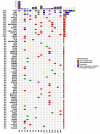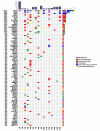Pathogenic and Targetable Genetic Alterations in Resected Recurrent Undifferentiated Pleomorphic Sarcomas Identified by Targeted Next-generation Sequencing
- PMID: 31018952
- PMCID: PMC6542646
- DOI: 10.21873/cgp.20127
Pathogenic and Targetable Genetic Alterations in Resected Recurrent Undifferentiated Pleomorphic Sarcomas Identified by Targeted Next-generation Sequencing
Abstract
Background/aim: Undifferentiated pleomorphic sarcomas (UPSs) are difficult to treat, with a high recurrence rate. However, the genetic and molecular characterization of recurrent UPS has not been identified.
Patients and methods: In this study, we investigated the pathogenic and targetable genetic alterations in 16 paired locally pre-recurrent and post-recurrent UPS cases by targeted next-generation sequencing (466 genes).
Results: Sequence variations were most frequently found in TP53 (66%), ATRX (34%), and RB1 (28%). In addition, for the first time, recurrent IL7R gene amplification (19%) and KMT2C gene mutation (16%) were detected in UPS. Interestingly, genetic alterations varied with tumor relapse. Importantly, targetable driver variants were found in recurrent UPS. Mutated genes were correlated with the cell cycle, PI3K/mTOR and RAS/MAPK signaling pathways. TMB was also found to be increased after tumor recurrence (4.6 vs. 7.5 mutations/MB, p=0.0343).
Conclusion: Routine use of targeted next-generation sequencing for recurrent UPS can facilitate timely therapeutic decision-making.
Keywords: NGS; Soft tissue sarcoma; next generation sequencing; recurrence; targetable genetic alterations; undifferentiated pleomorphic sarcoma.
Copyright© 2019, International Institute of Anticancer Research (Dr. George J. Delinasios), All rights reserved.
Conflict of interest statement
The Authors disclose no potential conflicts of interest regarding this study.
Figures




Similar articles
-
Identifying actionable variants using next generation sequencing in patients with a historical diagnosis of undifferentiated pleomorphic sarcoma.Int J Cancer. 2018 Jan 1;142(1):57-65. doi: 10.1002/ijc.31039. Epub 2017 Oct 9. Int J Cancer. 2018. PMID: 28891048
-
Profiling of potential driver mutations in sarcomas by targeted next generation sequencing.Cancer Genet. 2016 Apr;209(4):154-60. doi: 10.1016/j.cancergen.2016.02.004. Epub 2016 Feb 15. Cancer Genet. 2016. PMID: 26987750
-
Molecular profiling of soft tissue sarcomas using next-generation sequencing: a pilot study toward precision therapeutics.Hum Pathol. 2014 Aug;45(8):1563-71. doi: 10.1016/j.humpath.2014.04.012. Epub 2014 Apr 24. Hum Pathol. 2014. PMID: 24908143
-
The Role of Next-Generation Sequencing in Sarcomas: Evolution From Light Microscope to Molecular Microscope.Curr Oncol Rep. 2017 Oct 13;19(12):78. doi: 10.1007/s11912-017-0641-2. Curr Oncol Rep. 2017. PMID: 29030741 Review.
-
Role of Next-Generation Sequencing as a Diagnostic Tool for the Evaluation of Bone and Soft-Tissue Tumors.Pathobiology. 2017;84(6):323-338. doi: 10.1159/000478662. Epub 2017 Aug 18. Pathobiology. 2017. PMID: 28817827 Review.
Cited by
-
Deep Genomic Sequencing of Bladder Urothelial Carcinoma in Southern Chinese Patients: A Single-Center Study.Front Oncol. 2021 May 14;11:538927. doi: 10.3389/fonc.2021.538927. eCollection 2021. Front Oncol. 2021. PMID: 34055593 Free PMC article.
-
Multiple malignant tumors in a patient with familial chordoma, a case report.BMC Med Genomics. 2021 Aug 31;14(1):213. doi: 10.1186/s12920-021-01064-0. BMC Med Genomics. 2021. PMID: 34465320 Free PMC article.
-
Transformed Canine and Murine Mesenchymal Stem Cells as a Model for Sarcoma with Complex Genomics.Cancers (Basel). 2021 Mar 5;13(5):1126. doi: 10.3390/cancers13051126. Cancers (Basel). 2021. PMID: 33807947 Free PMC article.
-
Comprehensive genomic profile of cholangiocarcinomas in China.Oncol Lett. 2020 Apr;19(4):3101-3110. doi: 10.3892/ol.2020.11429. Epub 2020 Mar 3. Oncol Lett. 2020. PMID: 32256810 Free PMC article.
-
A case of adrenal undifferentiated pleomorphic sarcoma with tertiary lymphoid structures responded to pembrolizumab.IJU Case Rep. 2023 Sep 14;6(6):440-444. doi: 10.1002/iju5.12643. eCollection 2023 Nov. IJU Case Rep. 2023. PMID: 37928308 Free PMC article.
References
-
- Canter RJ, Beal S, Borys D, Martinez SR, Bold RJ, Robbins AS. Interaction of histologic subtype and histologic grade in predicting survival for soft-tissue sarcomas. J Am Coll Surg. 2010;210(2):191–198 e192. PMID: 20113939. DOI: 10.1016/j.jamcollsurg.2009.10.007. - PubMed
-
- Gibault L, Perot G, Chibon F, Bonnin S, Lagarde P, Terrier P, Coindre JM, Aurias A. New insights in sarcoma oncogenesis: A comprehensive analysis of a large series of 160 soft tissue sarcomas with complex genomics. J Pathol. 2011;223(1):64–71. PMID: 21125665. DOI: 10.1002/path.2787. - PubMed
-
- Serrano C, Romagosa C, Hernandez-Losa J, Simonetti S, Valverde C, Moline T, Somoza R, Perez M, Velez R, Verges R, Dominguez R, Carles J, Ramon YCS. Ras/mapk pathway hyperactivation determines poor prognosis in undifferentiated pleomorphic sarcomas. Cancer. 2016;122(1):99–107. PMID: 26479291. DOI: 10.1002/cncr.29733. - PubMed
MeSH terms
Substances
LinkOut - more resources
Full Text Sources
Medical
Research Materials
Miscellaneous
